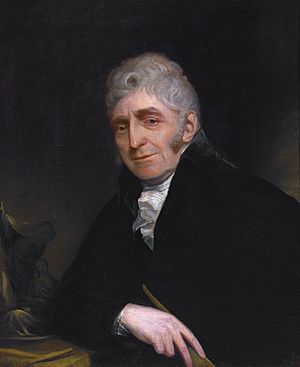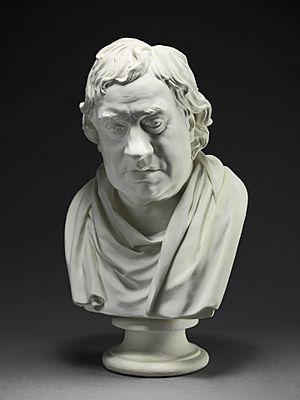Joseph Nollekens facts for kids
Quick facts for kids
Joseph Nollekens
|
|
|---|---|

Joseph Nollekens.
|
|
| Born | 11 August 1737 Soho, London
|
| Died | 23 April 1823 (aged 85) |
| Occupation | British sculptor |

Joseph Nollekens (born August 11, 1737 – died April 23, 1823) was a famous sculptor from London. Many people think he was the best British sculptor of the late 1700s. He was especially known for making detailed busts, which are sculptures of a person's head and shoulders.
Contents
Early Life and Training
Joseph Nollekens was born in Soho, London, on August 11, 1737. His father, Josef Frans Nollekens, was a painter from a region called Flanders (now part of Belgium). His father had moved to London a few years before Joseph was born.
Joseph first learned about sculpting from another artist from Flanders, Peter Scheemakers. Later, around 1760 or 1762, Joseph traveled to Rome, Italy. Rome was a very important city for art. While there, he studied art, worked with old statues, and even made copies of famous sculptures. He also bought and sold antique art.
In Rome, Joseph created some important sculptures. One was a marble piece called Timocles Before Alexander. He won an award for this work. He also made busts of famous visitors to Rome, like the writer Laurence Sterne and the actor David Garrick.
Becoming a Famous Sculptor
Joseph Nollekens returned to London in 1770. He opened his own studio where he made busts and monuments. A monument is a statue or structure built to remember a person or event. His studio quickly became very popular.
Even though he liked to sculpt mythological characters (like gods and goddesses from old stories), he became most famous for his portrait busts. These were sculptures that looked exactly like real people. He became one of the most fashionable sculptors in Britain. In 1772, he married Mary Welch. Her father was a judge and a grocer.
Sculpting Important People
Nollekens was very lucky to have the support of King George III. This meant the King liked his work and often asked him to create sculptures. Joseph went on to sculpt many important British political figures. These included King George III himself, William Pitt the Younger, and Charles James Fox. He also made busts of artists like Benjamin West.
Most of the people he sculpted were shown wearing classical costumes, which were popular in ancient Greece and Rome.
His Best Work: 'Faith'
One of Nollekens' most famous works is a sculpture called Faith. A man named Henry Howard asked him to create it after his wife, Maria, died in 1788. This sculpture is thought to be Nollekens' finest work. You can see Faith in the Howard Chapel at the Parish Church of Wetheral, in Cumbria, England.
How Sculptures Were Made
Joseph Nollekens was very careful when he made the first models of his sculptures. He paid close attention to every small detail. However, the final marble versions were usually carved by his assistants. Two of his assistants were Sebastian Gahagan and L. Alexander Goblet. For example, Sebastian Gahagan carved Nollekens' large statue of William Pitt for a building at Cambridge University.
Some of Nollekens' sculptures were so popular that many copies were made. For instance, more than 70 copies of his bust of William Pitt are known to exist!
Nollekens became a member of the Royal Academy of Arts. He was made an associate in 1771 and a full academician (a top member) the next year.
Later Life and Legacy
Joseph Nollekens died in London in 1823. He had earned a lot of money from his work. He left about £200,000 in his will, which was a huge amount of money back then. He is buried in Paddington Parish Church. There is a monument there made by another sculptor, William Behnes.
A book about his life, called Nollekens and his Times, was published in 1828 by John Thomas Smith. Smith was the person who managed Nollekens' will. The book gave a very detailed look at Nollekens' life.
Today, a building at 44 Mortimer Street in London stands where Nollekens' house used to be. There is a special blue plaque on the building to remember him. The American poet Randall Jarrell also wrote a poem about Nollekens in 1956.
Images for kids


